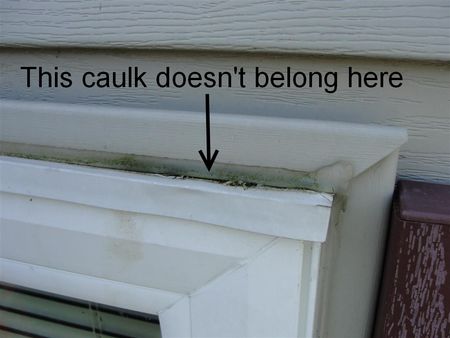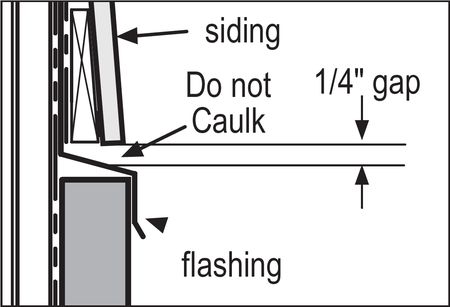Last week I blogged about not caulking at the base of storm windows, which is a simple no-brainer. Another place that should never be caulked is the space between the siding and the flashing above a window; this piece of flashing is often referred to as drip flashing, drip cap, or head flashing. Caulking this opening shut is a very common defect, even on new construction.
Why not caulk here? The head flashing at the window provides a drainage plane for water that could potentially get in behind the siding; the head flashing allows the water to drain out above the top of the window. If the space between the flashing and the siding gets caulked shut, where will water go? It will get trapped behind the siding and potentially cause damage to the home.
Some siding manufacturers already require this space to be left open, such as fiber-cement siding manufacturers. Unfortunately, this detail isn’t spelled out in any window installation instruction manuals, or if it is, I haven’t found them yet. I also haven’t found any vinyl siding manufacturers that specifically say “don’t caulk here“. For fiber-cement siding, it’s an installation defect. For just about any other type of siding, including vinyl, it’s a ‘best practice’ not to caulk here.
Just wait though… I’m sure that the manufacturers of windows and other types of siding will catch up on this detail soon enough, and they’ll start explicitly telling you “don’t caulk here”. Installation instructions for windows are getting longer and more specific every year. Case in point: about ten years ago, Windsor Windows published a one page installation sheet; today it’s a ten page installation manual. Did the windows change significantly? No. Manufacturers are just doing their part to help prevent failures from improper installations.
Is this really a defect? Well, technically no, not on all installations. It’s not a defect until the manufacturers put it in writing or it’s specified in the building code… but it sure isn’t wise.
Reuben Saltzman, Structure Tech Home Inspections – Email – Minneapolis Home Inspections


